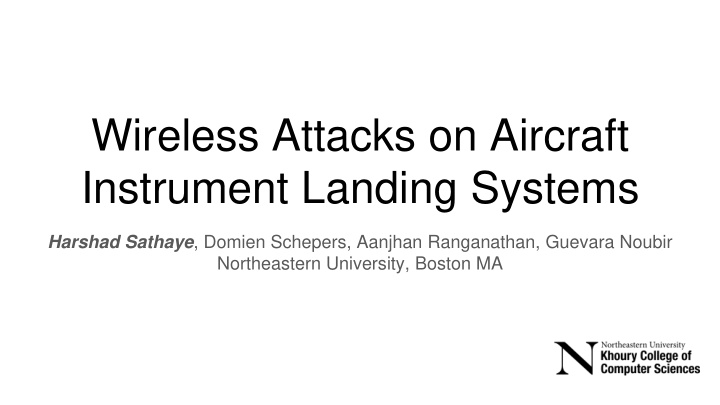



Wireless Attacks on Aircraft Instrument Landing Systems Harshad Sathaye , Domien Schepers, Aanjhan Ranganathan, Guevara Noubir Northeastern University, Boston MA
15000 flights!! 2 https://www.flightradar24.com/1.27,51.96/3
ACAS/TCAS Traffic and Collision Avoidance Automatic Dependent Surveillance Broadcast Surveillance Radar for ! aircraft localization Global Navigation Satellite System Voice communications over VHF links Instrument Landing System 3
Aircraft Instrument Landing System (ILS) Final approach or landing phase is one of ● the most critical phases According to Boeing 59% of the fatal ● accidents occur during the final approach phase ILS provides precise lateral and vertical ● guidance even in extreme weather conditions using wireless radio signals 4
5
6
Our contributions Demonstrate two types of attacks: 1) Overshadow and 2) Single-tone attack for taking ● over ILS Develop a closed loop tightly controlled ILS spoofer that in real-time adjusts the ● spoofing signals as a function of aircraft’s current location Demonstrate the attacks on a flight simulator software which satisfies FAA ● certification requirements (X-Plane) Systematically evaluate the performance of the attack using X- Plane’s AI based ● autoland feature resulting in touchdown offsets of 18 meters to over 50 meters 7
Localizer Enables the receiver to calculate its location with respect to the runway centerline ● The instrument guides the pilot to properly align itself ● Antenna array installed at the end of the runway transmits a 25W signal ● Transmission pattern creates a lobe on each side of the runway ● centerline: Runway Centerline Localizer Antenna 90 Hz 150 Hz 8
Glideslope Enables the receiver to calculate its location with respect to the glidepath ● The instrument guides the pilot to set a perfect glidepath angle ● Antenna installed near the touchdown zone transmits an 8W signal ● Transmission pattern creates a lobe on each side of the glidepath ● Glideslope Antenna 90 Hz 150 Hz Touchdown Zone 9
ILS Transmitter 90 Hz 150 Hz Antenna Elements 10
ILS Receiver 11
Wireless Attacks Needle deflection depends only on the power of the received 90 Hz and 150 Hz tones! ● Objective of the attacker: ● ○ Manipulate DDM calculation ○ Force the aircraft to overshoot the runway or completely miss the approach We discuss two attacks: ● ○ Overshadow attack ○ Single-tone attack With minor changes, the attacks work for both the localizer and the glideslope 12
Wireless Attacks: Overshadow Attack Attacker transmits a high power pre-crafted ILS signals ● A typical wireless receiver always locks on to the stronger signal ● It is sufficient to generate and transmit signals similar to the received legit ILS signal ● 13
Wireless Attacks: Single-tone Attack Attacker transmits only one of the two tones that make up the ILS signal ● Transmitted tone interferes with the existing tones to cause needle deflection ● The attacker signal is similar to a double sideband suppressed carrier signal which is ● known to be spectrally efficient than a regular AM signal 14
Attacker Challenges Aircraft can intercept the localizer from multiple directions ● ○ Sudden needle jumps ○ Leads to detection Spoofed flight path Legitimate flight path 15
Attacker Challenges Naïve overshadow attack results in fixed unreactive offset ● Stuck needle!! !? ○ Easy detection ○ Attack never succeeds Spoofed flight path Legitimate flight path 16
Offset Correction Algorithm Real time offset calculation and signal generation ● Adjusts attacker’s signal as a function of aircraft’s GPS location ● Provides a seamless takeover of the onboard instrument ● Current position B Legitimate flight path C A D Spoofed flight path 17
Spoofing Zone Detector Enables timely and automated triggering of the attack ● Detects if the target aircraft has entered the area of final approach ● Avoid sudden needle jumps ● Spoofed flight path Legitimate flight path 18
Experimental Setup 19
Experimental Setup 20
21
Evaluation of Overshadow Attack ● 5 test flights with AI based automated landing were flown for each spoofed offset ● Even minute offsets have significant effects ● A certified pilot was called in to test the setup and fly the approach with and without spoofing 22
Evaluation of Single-tone Attack Single-tone attack is susceptible to phase ● changes Effect was less severe on the handheld ● receiver: It depends on: ○ Speed of the approaching aircraft ○ Refresh rate of the instrument Amplitude scaling for countering the effect of ● phase Unpredictable needle deflections can be used ● as a low power last minute DoS attack 23
Summary ILS is vulnerable to spoofing attack ● The attacks were successfully demonstrated on flight simulator software which ● satisfies FAA certification requirements Pure analog nature makes it fundamentally challenging to secure these critical ● navigation systems Pilots have multiple other systems which they can rely on for recovery if the attack is ● detected in time Thank you! sathaye.h@husky.neu.edu harshadsathaye.com 24
Potential Countermeasures Introduction of GPS based landing systems which uses ground based augmentation ● Secure localization technology ● Signal strength monitoring for overshadow attack detection ● Transmitter detection inside the cabin to detect malicious activity ● Non-technical countermeasure: effective pilot training ● 26
Comparison of Power Requirements Localizer Glideslope 27
Recommend
More recommend